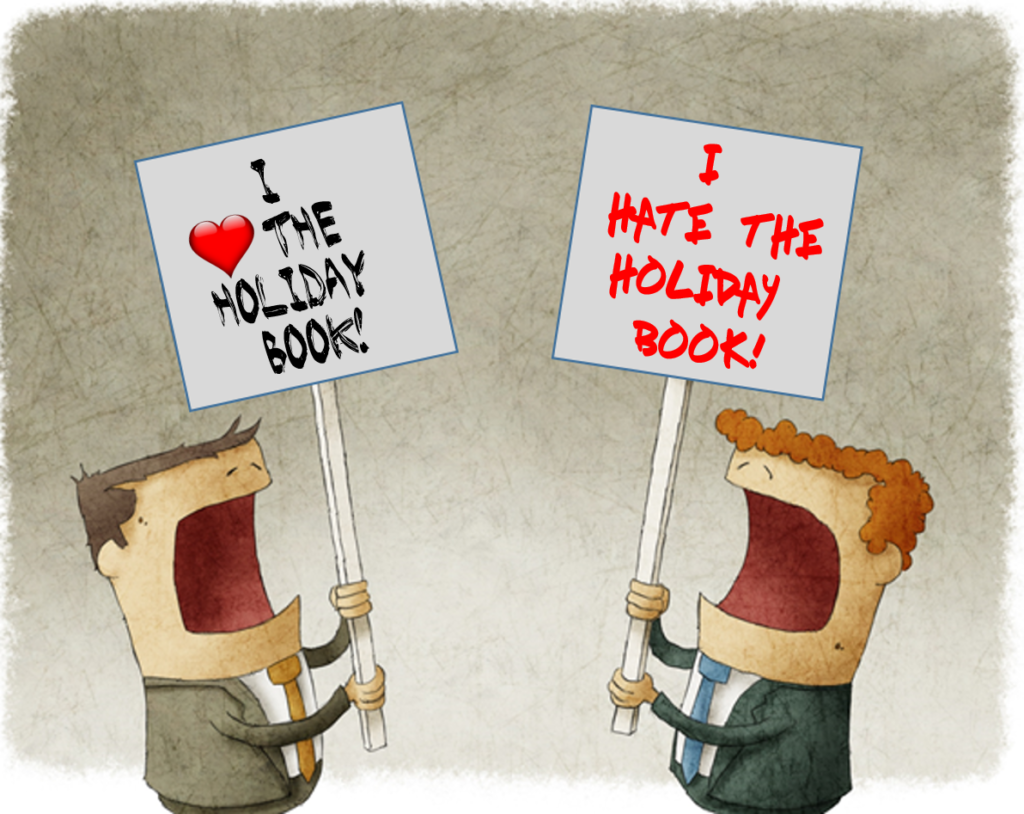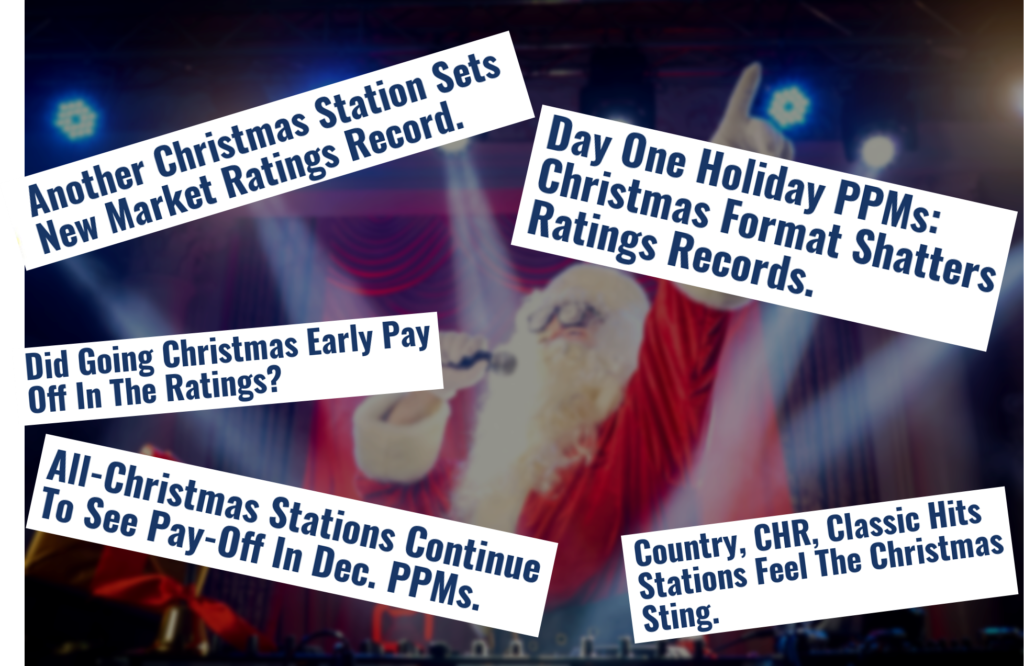
Last week was another exciting week in radio. As 2020 began to gain steam, Nielsen began to release its Holiday book – technically the 13th PPM report of the year.
This much-maligned book has been around since meters became the currency in the nation’s biggest 48 markets. And yet, it makes a lot of broadcasters – programmers, sales managers, and owners – absolutely nuts. I talk to a lot of radio people in PPM markets who just don’t understand why this report exists.
First, they’re paying for a report that many don’t use (unless, of course, you’re the holiday music station).
Second, some feel it confuses the issue, providing a ratings reports at the most anomalous time of the year.
Third, even though most broadcasters intellectually know Holiday weeks don’t reflect a station’s true performance the other 11 months of the year – some still emotionally react to these reports in the worst possible ways.
If you’re playing Christmas music in November and December, Holiday is a wonderful reflection of your specialty programming – in ways that now have an outsized impact in a growing number of markets.
Inside Radio, AllAccess, Radio Ink, and other industry trades have been writing blaring headlines these two weeks, lauding the amazing performance of Holiday music stations….
….while the other 90% of stations cool their heels, waiting for all of this to blow over. In most parts of the country, no one’s looking forward to January. But in radio’s PPM markets, it has now become a friendly month for many.

So, now that you’re gotten this far in this post, you may be thinking I sound like a disgruntled, whiny PD who’s just gotten a bad book.
I bet the first day of my radio career way back in the 1970s, there was complaining about the ratings. Back then, it was Arbitron, of course, and now, Nielsen is in the cross hairs.
And grousing about the ratings isn’t just a sport, it’s become an art form – especially as technology has allowed programmers to see under the hood, especially in metered markets.
So, why is there a Holiday book? Is it necessary? And what’s the thinking behind surveying during the holidays each year?
To get the perspective I was lacking, I went right to Brad Kelly, Nielsen Audio’s Managing Director. Yes, I knew I was going to get the company line,  but Brad’s a thoughtful industry professional who’s heard it all before – the kudos, the brickbats, and everything in between.
but Brad’s a thoughtful industry professional who’s heard it all before – the kudos, the brickbats, and everything in between.
First, Brad reports that most stations that go all-Christmas are using historical comps from these Holiday books to make their case for higher rates in real time – November and December.
That’s something that has bothered me in the past – Christmas music destabilizes a radio market, and yet, many of these stations don’t even garner considerably higher rates. Kelly says stations have gotten smarter since the early days of the Holiday Book.
And to get a measure of how a radio market looks once those Christmas trees are hauled off and the decorations are put away until next year, many buyers (and sellers) are looking at November-December-January in their averages – sans the Holiday Book, realizing it is atypical from these rest of the year, not reflective of audience delivery for an ad schedule placed to run in Q1.
OK, so then why does it exist?
Brad reminded me of the many sporting events that are broadcast on the radio during these weeks – yet, another reason why measurement is key. Sports radio stations in PPM markets are especially reliant on the Holiday Book, and for good reason.
And many stations program charity radiothons and other community events during this season, and Holiday provides a reflection of their ratings impact.

But then there’s the PPM thing.
To put the entire system on hiatus for four weeks, and then trying to jumpstart in for the January book presents both logistical and compliance problems for the company and for the panel.
Brad likens it to an auto assembly line where it’s more cost-effective to have the operation run 24/7, rather than to start it, stop it, and then start it again. Not to mention 80,000 panelists are being compensated for this period anyway.
A key to achieving consistent cooperation for the entire year is to survey during these Holiday weeks – even though many people are on vacation, shopping, or otherwise distracted.
 Like a lot of things in business, politics, and life, the Holiday Book cuts both ways, favoring some stations, punishing others, but reflecting the reality of radio listening during the season.
Like a lot of things in business, politics, and life, the Holiday Book cuts both ways, favoring some stations, punishing others, but reflecting the reality of radio listening during the season.
For many stations committed to building great brands that can stand the test of time, Holiday is an annual speed bump that is simply part of the game. It’s a reflection of what’s happening in the biggest radio markets during a time of year when shopping, sports, family, and celebration overtake our lives.
Much as I dread this period as a consultant and programmer, the researcher in me acknowledges the value of learning about the lifestyle impact of this time of year.
And let’s face it, Holiday is a challenge for the other 90% of stations in the market to figure out ways to make their brands matter each December, in spite of the headwinds.
The better we execute, the quicker the numbers bounce back in January.
That would be a nice post-Holiday present
- What To Do If Your Radio Station Goes Through A Midlife Crisis - April 25, 2025
- A 2020 Lesson?It Could All Be Gone In A Flash - April 24, 2025
- How AI Can Give Radio Personalities More…PERSONALITY - April 23, 2025




Christmas music is a disruptor, clearly, in the Holiday survey. But I’d argue that the bigger problems for many stations are a) overall radio usage drops as listeners take vacation from work; and b) most of radio’s biggest star talent disappear on vacation too. Christmas music itself impacts markets in the same way that a big snowstorm or even a local team in the World Series impacts markets. But it’s the combination with the overall depressed usage of radio that makes the Holiday book extra challenging.
Agree, Carl. It IS a reflection of what people are doing (or aren’t doing) during the holidays. It is what it is.
We’re in a diary market, but are only buying the Spring and Fall books, mainly because Summer and Winter are Metro only, not TSA. Also the Summer book is really skewed in a number of ways:
School out disruptions (lots of college students leave town)
Summer Vacations
California burning down
Nielsen would argue there are “anomalies” in every rating book – weather, the holidays, natural disasters, sports teams vying for championships, etc. After a while (and I’ve lived in 4-book, year-round ratings my entire career), you begin to view the year as a marathon – not a series of chapters. But if you guys are able to make your numbers buying two books, more power to you.